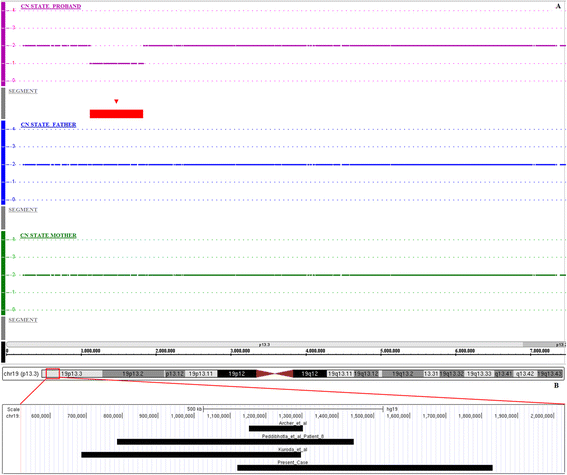Clinical and molecular characterization of a de novo 19p13.3 microdeletion
- PMID: 27239227
- PMCID: PMC4882821
- DOI: 10.1186/s13039-016-0252-x
Clinical and molecular characterization of a de novo 19p13.3 microdeletion
Abstract
Background: Structural rearrangements of chromosome 19p13.3 are a rare condition, and their phenotypic consequences remain not well defined, because of the variability of clinical manifestations. Increasing knowledge of new 19p13.3 microdeletion is useful to clarify the phenotypic variability observed in some patients. In a small number of recent papers, patients with intellectual disabilities, multiple congenital anomalies and microdeletion of the chromosome band 19p13.3 have been described. However, little is known about genes responsible for clinical features in patients carriers of 19p13.3 microdeletion; thus, increasing number of reported cases will be helpful to investigate the contribution of candidate genes, providing bases for future investigations.
Case presentation: Here, we report on a 10-years-old girl referred to our genetics clinic due to intellectual disability, attention deficit, behavioral and speech delay, hypotonia, facial dysmorphisms, eye anomalies and congenital malformations. Using an high resolution SNP array, we identified a de novo microdeletion of chromosome 19p13.3, resulting in the heterozygous loss of 27 RefSeq genes and a miRNA, partially overlapping with three others deletions already reported in literature, but extending downstream (centromeric) for additional 386 Kb. This chromosomal region includes 13 genes amongst of which we suggest for the first time the APC2, PLK5 and MBD3 genes as potential functional candidates for neurodevelopmental and behavioral phenotypes observed.
Conclusions: Here we describe a patient with a 19p13.3 microdeletion that spans to the downstream chromosomal region with respect to the overlapping deletions previously reported in several other cases. The neurobehavioral features observed in our case has extended the phenotypic spectrum associated with the 19p13.3 microdeletion. New candidate genes are proposed for the neurobehavioral phenotype observed in our case.
Keywords: 19p13.3 microdeletion; Intellectual disabilities; SNP-Array analysis.
Figures


Similar articles
-
A new case of de novo 19p13.2p13.12 deletion in a girl with overgrowth and severe developmental delay.Mol Cytogenet. 2014 Jun 5;7:40. doi: 10.1186/1755-8166-7-40. eCollection 2014. Mol Cytogenet. 2014. PMID: 24963350 Free PMC article.
-
Clinical and molecular characterization of an emerging chromosome 22q13.31 microdeletion syndrome.Am J Med Genet A. 2018 Feb;176(2):391-398. doi: 10.1002/ajmg.a.38559. Epub 2017 Nov 28. Am J Med Genet A. 2018. PMID: 29193617
-
First prenatal case of proximal 19p13.12 microdeletion syndrome: New insights and new delineation of the syndrome.Eur J Med Genet. 2018 Jun;61(6):322-328. doi: 10.1016/j.ejmg.2018.01.009. Epub 2018 Feb 3. Eur J Med Genet. 2018. PMID: 29366875
-
Microdeletion of 12q24.31: report of a girl with intellectual disability, stereotypies, seizures and facial dysmorphisms.Am J Med Genet A. 2015 Feb;167A(2):438-44. doi: 10.1002/ajmg.a.36872. Epub 2014 Nov 26. Am J Med Genet A. 2015. PMID: 25428890 Review.
-
The discovery of microdeletion syndromes in the post-genomic era: review of the methodology and characterization of a new 1q41q42 microdeletion syndrome.Genet Med. 2007 Sep;9(9):607-16. doi: 10.1097/gim.0b013e3181484b49. Genet Med. 2007. PMID: 17873649 Review.
Cited by
-
Copy Number Variation Analysis of Euploid Pregnancy Loss.Front Genet. 2022 Mar 23;13:766492. doi: 10.3389/fgene.2022.766492. eCollection 2022. Front Genet. 2022. PMID: 35401693 Free PMC article.
-
Ocular Manifestations of a Novel Proximal 19p13.3 Microdeletion.Case Rep Genet. 2018 Apr 30;2018:2492437. doi: 10.1155/2018/2492437. eCollection 2018. Case Rep Genet. 2018. PMID: 29854496 Free PMC article.
-
The Genetic Architecture of the Human Corpus Callosum and its Subregions.bioRxiv [Preprint]. 2024 Jul 26:2024.07.22.603147. doi: 10.1101/2024.07.22.603147. bioRxiv. 2024. PMID: 39091796 Free PMC article. Preprint.
-
Molecular Alterations in Meningioangiomatosis Causing Epilepsy.J Neuropathol Exp Neurol. 2021 Nov 19;80(11):1043–1051. doi: 10.1093/jnen/nlab095. Epub 2021 Sep 27. J Neuropathol Exp Neurol. 2021. PMID: 34580720 Free PMC article.
-
Atypical nested 22q11.2 duplications between LCR22B and LCR22D are associated with neurodevelopmental phenotypes including autism spectrum disorder with incomplete penetrance.Mol Genet Genomic Med. 2019 Feb;7(2):e00507. doi: 10.1002/mgg3.507. Epub 2019 Jan 4. Mol Genet Genomic Med. 2019. PMID: 30614210 Free PMC article.
References
-
- Grimwood J, Gordon LA, Olsen A, Terry A, Schmutz J, Lamerdin J, Hellsten U, Goodstein D, Couronne O, Tran-Gyamfi M, Aerts A, Altherr M, Ashworth L, Bajorek E, Black S, Branscomb E, Caenepeel S, Carrano A, Caoile C, Chan YM, Christensen M, Cleland CA, Copeland A, Dalin E, Dehal P, Denys M, Detter JC, Escobar J, Flowers D, Fotopulos D, Garcia C, Georgescu AM, Glavina T, Gomez M, Gonzales E, Groza M, Hammon N, Hawkins T, Haydu L, Ho I, Huang W, Israni S, Jett J, Kadner K, Kimball H, Kobayashi A, Larionov V, Leem SH, Lopez F, Lou Y, Lowry S, Malfatti S, Martinez D, McCready P, Medina C, Morgan J, Nelson K, Nolan M, Ovcharenko I, Pitluck S, Pollard M, Popkie AP, Predki P, Quan G, Ramirez L, Rash S, Retterer J, Rodriguez A, Rogers S, Salamov A, Salazar A, She X, Smith D, Slezak T, Solovyev V, Thayer N, Tice H, Tsai M, Ustaszewska A, Vo N, Wagner M, Wheeler J, Wu K, Xie G, Yang J, Dubchak I, Furey TS, DeJong P, Dickson M, Gordon D, Eichler EE, Pennacchio LA, Richardson P, Stubbs L, Rokhsar DS, Myers RM, Rubin EM, Lucas SM. The DNA sequence and biology of human chromosome 19. Nature. 2004;428:529–35. doi: 10.1038/nature02399. - DOI - PubMed
-
- Peddibotha S, Khalifa M, Probst FJ, Stein J, Harris LL, Kearney DL, Vance GH, Bull MJ, Grange DK, Scharer GH, Kang SL, Stankieicz P, Bacino CA, Cheung SW, Patel A. Expanding the genotype-phenotype correlation in subtelomeric 19p13.3 microdeletions using high resolution clinical chromosomal microarray analysis. Am J Med Gen A. 2012;161:2953–63. doi: 10.1002/ajmg.a.35886. - DOI - PubMed
-
- Souza J, Faucz F, Sotomaior V, Filho AB, Rosenfeld J, Raskin S. Chromosome 19p13.3 deletion in a child with Peutz-Jeghers syndrome, congenital heart defect, high myopia, learning difficulties and dysmorphic features: Clinical and molecular characterization of a new contiguous gene syndrome. Genet Mol Biol. 2011;34:557–61. doi: 10.1590/S1415-47572011005000044. - DOI - PMC - PubMed
Publication types
LinkOut - more resources
Full Text Sources
Other Literature Sources
Miscellaneous

